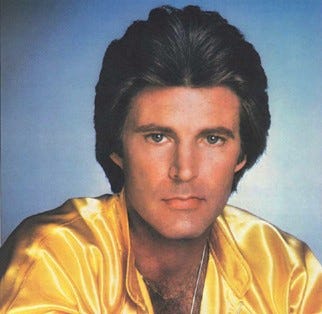Elvis Presley, Carl Perkins, the Rock ’N Roll Trio, and other Memphis cats weren’t the only ones tearing it up when rockabilly first hit the airwaves and jukeboxes in the mid-1950s. Out West in Hollywood, teenage Ricky Nelson, youngest son of America’s favorite TV family, was creating some of the genre’s purest, most enduring singles.
Born in 1940 to band leader Ozzie Nelson and singer Harriet Hilliard, Ricky began performing on the family’s radio show in 1949. Three years later, The Adventures of Ozzie and Harriet moved to television, and for 14 years America watched brothers David and Ricky grow up. To escape his fishbowl existence, Ricky began playing guitar when he was 14.
Infatuated with the music of Carl Perkins, in 1957 Ricky cut a demo to impress a girlfriend. Verve Records signed him and hired first-call L.A. session aces such as guitarists Howard Roberts and Barney Kessel to back him in the studio. On April 10, 1957, Ricky strummed guitar and lip-synched his first Verve single, “I’m Walkin’,” to an estimated television audience of 15 million viewers. The song rocketed to #4, 10,000 letters a week came rolling in, and a fence was erected around the Nelson house to hold back adoring girls.
Easygoing on TV, Ozzie was, behind the scenes, hard-driving and shrewd. He set up a new deal with Imperial, hired a youthful, skin-tight backing band, and made sure each new single was in record shops before Ricky and the boys played it on TV. At his earliest Imperial sessions, Ricky was backed by fleet-fingered guitarist Joe Maphis, whose scrappy guitar solos energized “Boppin’ the Blues” and “Waitin’ in School.” During a visit to the Imperial office, Nelson heard James Burton, also sixteen and already a master of country, blues, and rock and roll guitar. As Nelson recalled in our interview, “I thought, ‘Wow!’ I loved the way he played.”
Raised in Shreveport, Louisiana, Burton had already soloed on Dale Hawkins’ “Susie-Q” and was a regular on the Louisiana Hayride TV show. Taking over as Nelson’s sole guitarist, the Tele-toting Burton careened, caressed, and finessed his way through “Believe What You Say,” “It’s Late,” “Just a Little Too Much,” “Milk Cow Blues,” “Hello Mary Lou,” and other classics. Sparkling gems, his solos were recorded through a Fender Vibrasonic or Concert set for a clear tone with a lot of presence and highs. While Burton appeared on The Adventures of Ozzie and Harriet with a Gretsch Chet Atkins, Rickenbacker, or dark Fender Telecaster with a Strat neck, he almost invariably used a maple-neck ’53 Tele for sessions. Nelson, meanwhile, strummed a Martin D-35.
Kids eagerly tuned in to each new episode of Ozzie and Harriet, hoping for another rock and roll performance. With the release of Ricky, the 17-year-old became the youngest artist to have a #1 album. By 1958 Nelson was touring as a single act – rare in early rock and roll – and outhitting Elvis.
No mere teen idol, Ricky Nelson created some of the era’s finest rockabilly and pop records. With Ozzie, Ricky, and Jimmy Haskell producing, these sessions took place in Los Angeles at Master Recorders and United Recording. Ricky was very much involved in the process, selecting songs and shaping sounds. “The records hold up today,” Haskell remembered, “because Rick was conscientious. He would never accept the take until everybody’s playing was perfect.”
The hits rolled in until the early=to-mid 1960s, when the British Invasion reshaped pop. Stifled by a contract that forbid outside projects, Burton left Nelson in ’65 to join the Shindig house band and play sessions. He helped pioneer the “Bakersfield sound,” worked with Gram Parsons and Emmylou Harris, and, in 1969, landed in Elvis Presley’s band.
Nelson, meanwhile, had trouble breaking out of the teen idol stereotype. After the cancellation of the family show, Nelson hit a commercial dry spell. By the late ’60s, though, he was back in the saddle, pioneering country-rock with the Stone Canyon Band. He climbed atop the charts for the last time in 1972 with his self-penned “Garden Party.” During the next decade, Rick Nelson, as he was now billed, recorded albums for MCA, Capitol, and Epic, and toured up to 250 days a year. When we did our interview on June 16, 1981, it seemed like I’d known him all of my life – and, in a way, I guess I had.
###
Who are the best guitarists you’ve worked with?
Oh, boy. You know, it’s so hard to say. I think the two best are probably James Burton, who is really an innovator in guitar playing, and Bobby Neal. But it’s so hard to generalize, because they have really different styles.
When James Burton joined your band, how well known was he?
He wasn’t well known at all, really. The first time I heard him was in the office at Imperial Records. He came up from the Louisiana Hayride with Bob Luman. Actually, Bob Luman was auditioning for Imperial. I was looking for a band at that time. I was sixteen and so was James. I heard this guitar playing at the end of the hall. I thought, “Wow, I love the way he plays.”
Your promo material mentioned that you recorded “A Teenager’s Romance” after your girlfriend said she liked Elvis.
Yeah, I did that, and the other side was “I’m Walkin’.”
Were you interested in rock and roll before then?
Yeah, very much so. I remember the first truly rock and roll record that I ever heard was with Carl Perkins. It was “Blue Suede Shoes.”
Keep reading with a 7-day free trial
Subscribe to Talking Guitar ★ Jas Obrecht's Music Magazine to keep reading this post and get 7 days of free access to the full post archives.



